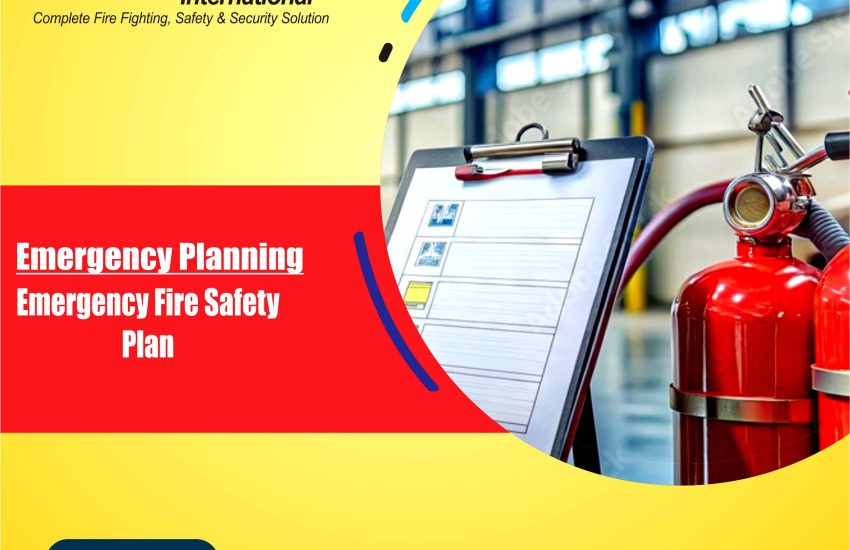Emergency Fire Safety Plan Fire safety is crucial for protecting lives and property, whether at home or in the workplace. A comprehensive Emergency Fire Safety Plan ensures that everyone knows how to respond promptly and effectively in the event of a fire. With proper preparation, you can reduce the risk of injury, prevent property damage, and save lives. This article outlines the key components of an emergency fire safety plan, its importance, and practical steps for creating one, using essential keywords for fire safety, emergency preparedness, fire drills, fire evacuation plan, and more.
Why Is an Emergency Fire Safety Plan Important?
A well-structured fire safety plan is critical in minimizing the dangers of a fire emergency. Fires can spread rapidly, causing significant damage and loss. By implementing an emergency fire safety plan, you ensure that all individuals within a building—whether at home or in a commercial space—are prepared for a fire emergency. This plan should address evacuation procedures, fire drills, fire extinguisher locations, and emergency contacts, helping everyone to respond swiftly and safely.
Key Components of an Emergency Fire Safety Plan
1. Fire Risk Assessment
Before implementing any fire safety measures, it is essential to conduct a fire risk assessment. Identify areas with the highest fire hazards, such as kitchens, electrical rooms, and storage areas. Evaluate the fire risks associated with each area and take preventive actions like installing smoke detectors, fire alarms, and sprinkler systems.
2. Fire Evacuation Plan
A fire evacuation plan outlines the steps employees or residents should take during a fire emergency. It should include:
- Evacuation routes: Ensure that the pathways are clear and accessible.
- Exit doors: Mark emergency exits clearly and ensure they remain unobstructed.
- Assembly points: Designate safe assembly points where everyone can gather after evacuation.
It’s essential that everyone in the building understands the evacuation plan. Regular fire drills help reinforce the procedures and identify any issues before an emergency occurs.
3. Fire Safety Equipment
Proper fire safety equipment is a vital part of any emergency fire safety plan. Ensure that your building is equipped with the following:
- Smoke detectors: Install smoke detectors in key areas such as kitchens and hallways.
- Fire extinguishers: Place fire extinguishers in easily accessible areas, ensuring employees or family members know how to use them.
- Fire alarms: Test fire alarms regularly to ensure they function properly in the event of a fire.
- Sprinkler systems: A functioning sprinkler system can help suppress fires before they escalate.
4. Employee/Resident Training
Training is one of the most effective ways to prepare for a fire emergency. Employee training or fire safety training should include:
- How to use fire extinguishers.
- Evacuation procedures during different types of fires (e.g., electrical fires, chemical fires).
- How to assist others, especially those with mobility challenges, during evacuation.
- The importance of keeping calm and not using elevators during a fire evacuation.
For homes, ensure everyone, including children and elderly members, knows the escape routes and what to do in case of fire.
5. Fire Drill Procedures
Fire drills are crucial for ensuring that all occupants know how to act quickly and efficiently in an emergency. Conduct regular fire drills at least once a year, preferably more frequently in high-risk environments. During these drills:
- Test evacuation routes and exits.
- Practice gathering at assembly points.
- Ensure everyone knows their responsibilities, such as helping others evacuate or notifying emergency services.
6. Emergency Contacts and Communication
A key element of any fire safety plan is having clear emergency contacts. Display contact information for local fire departments, emergency medical services, and building management (in the case of commercial buildings). In case of a fire, it is crucial that these numbers are easily accessible to everyone. Additionally, establish a communication plan for staying in touch with individuals during the evacuation process.
7. Post-Fire Recovery Plan
Once the fire is extinguished, the recovery phase begins. This includes conducting an assessment of any damage, notifying insurance companies, and ensuring that all affected individuals are accounted for. It’s also crucial to revisit and update the fire safety plan based on any lessons learned from the incident.
Best Practices for Fire Safety
- Inspect fire safety equipment regularly to ensure it is in working condition.
- Install smoke alarms and test them monthly to ensure they work.
- Keep fire exits and evacuation routes clear at all times.
- Ensure that all employees or household members are trained in basic fire safety, including fire extinguisher use and evacuation procedures.
- Make sure fire drills are conducted regularly and that everyone understands their role.
Conclusion
Emergency Fire Safety Plan is a vital component of any safety strategy, whether in a home or workplace. By conducting fire risk assessments, creating clear evacuation plans, ensuring proper fire safety equipment is in place, and training everyone in fire safety protocols, you can significantly reduce the risk of fire-related injuries and fatalities. Fire drills, regular equipment checks, and up-to-date emergency contacts are essential to ensuring the plan is effective when needed most.


